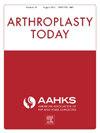Optimal Bone Preparation for Triple-Tapered Stems: Does the Sagittal Taper Affect Optimal Femoral Sizing?
IF 1.5
Q3 ORTHOPEDICS
引用次数: 0
Abstract
Background
Conventional single-tapered, total hip arthroplasty stems achieve fixation namely through coronal, metaphyseal fit. Triple taper stems have a sagittal taper to optimize fixation in the antero-posterior (AP) plane as well; however, limited guidance exists on appropriate bone preparation. Often, similar preparation techniques are used despite geometric differences which may lead to underpreparation. We’ve defined a novel technique in which a small portion of posterior femoral neck and cancellous bone is removed to permit preparation collinear to the diaphyseal sagittal femoral axis. We hypothesize this will optimize stem fit and stability compared to conventional techniques.
Methods
This is a retrospective review of 38 cementless primary total hip arthroplasty cases performed by a single surgeon. In each case, broach preparation was initially performed through the center of the femoral neck as although it was a single-tapered stem. Once tactile sensation of adequate fit was achieved, fluoroscopic images were taken to document AP and mediolateral fit, and stem size was recorded. Then that broach was removed, and a standardized one-third of the posterior femoral neck and posterior cancellous bone was removed, permitting broaches to prepare the femur collinear to the femoral diaphyseal sagittal axis— triple-tapered preparation (TTP). Outcomes included change in stem size from initial broach trial to final stem selection and radiographic stem fill on AP and lateral views.
Results
Median single-tapered preparation broach size was 8 (range, 5-12) and final stem size after TTP was 11 (range, 6-13). The TTP overall mean percent metaphyseal fill was 74 ± 6% in the AP view and 71 ± 5% in the lateral view, both significantly higher than single-tapered preparation which was 67 ± 7% and 65 ± 7%, respectively (P < .001). No fractures or loosening occurred in this series.
Conclusions
Preparation of triple-tapered stems collinear to the diaphyseal sagittal femoral axis improves stem size, fit, and fill.
求助全文
约1分钟内获得全文
求助全文
来源期刊

Arthroplasty Today
Medicine-Surgery
CiteScore
2.90
自引率
0.00%
发文量
258
审稿时长
40 weeks
期刊介绍:
Arthroplasty Today is a companion journal to the Journal of Arthroplasty. The journal Arthroplasty Today brings together the clinical and scientific foundations for joint replacement of the hip and knee in an open-access, online format. Arthroplasty Today solicits manuscripts of the highest quality from all areas of scientific endeavor that relate to joint replacement or the treatment of its complications, including those dealing with patient outcomes, economic and policy issues, prosthetic design, biomechanics, biomaterials, and biologic response to arthroplasty. The journal focuses on case reports. It is the purpose of Arthroplasty Today to present material to practicing orthopaedic surgeons that will keep them abreast of developments in the field, prove useful in the care of patients, and aid in understanding the scientific foundation of this subspecialty area of joint replacement. The international members of the Editorial Board provide a worldwide perspective for the journal''s area of interest. Their participation ensures that each issue of Arthroplasty Today provides the reader with timely, peer-reviewed articles of the highest quality.
 求助内容:
求助内容: 应助结果提醒方式:
应助结果提醒方式:


